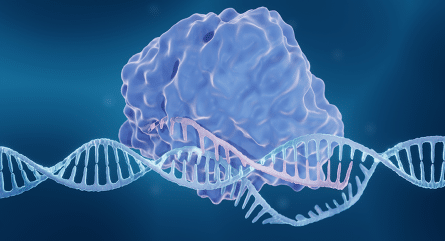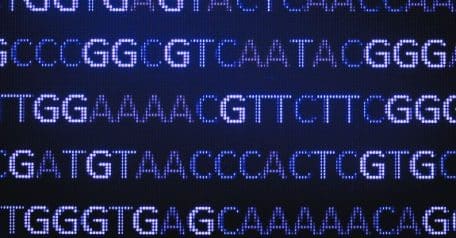The IDT Customer Care Team frequently receives calls during which representatives are asked to define qPCR terminology. In this article, we provide an introduction to some of the most commonly used terms and distinctions encountered in qPCR experiments.
What is real-time PCR and quantitative PCR (qPCR)?
Real-Time PCR refers to the fact that measurements are made in real time, during the amplification of the target DNA [1]. qPCR introduces the idea that the data provides quantification of the target DNA. That said, the terms are often used interchangeably.
Real-time PCR and qPCR reactions differ from regular PCR reactions with the addition of fluorescent based signal detection, either through the use of a double stranded DNA binding dye or a dual labeled fluorescent probe [2]. The fluorescence increases during the amplification and the increase in fluorescence correlates to the amount of starting template copies [2]. Since the number of copies theoretically doubles in each cycle, when comparing two amplifications, the primer/probe set with more copies of a template in a sample will amplify faster and release quantifiable fluorescence in an early cycle [2]. In contrast, a lower amount of beginning template will take more cycles to reach the same fluorescence intensity.
There are two options for analyzing qPCR results, relative quantification, or absolute quantification. Relative quantification compares the amplification curve to an internal standard mRNA or DNA; whereas absolute quantification interpolates the amount of target based on a standard curve created from serial dilutions of a known amount of DNA or RNA.
Quantification cycle (Cq) or threshold cycle (Ct)?
The cycle at which fluorescence from amplification exceeds the background fluorescence has been referred to as threshold cycle (Ct), crossing point (Cp), and take-off point (TOF) by different instrument manufacturers, but is now standardized by the MIQE guidelines as the quantification cycle (Cq). A lower Cq correlates with higher target expression in a sample.
Use of 5’ nuclease probes vs. intercalating dye primers in your assays
The two frequently-used variations of qPCR detection chemistry are 5' nuclease probes and intercalating dye. 5’ nuclease assays include two primers, and a probe that is labeled with a fluorescent dye and quencher(s). As the Taq polymerase extends from the primers, it encounters and degrades the annealed probe, separating the dye from the quencher and producing a detectable increase in fluorescence. Multiplex qPCR experiments require use of 5' nuclease probes whereby the probes are labeled with different dyes having distinct and separable absorbance spectra.
Intercalating dye primer sets depend on the ability of dyes such as SYBR®Green (Thermo Fisher Scientific), Cyto, EvaGreen®(Biotium), and LC Green®(Biofire Defense, LLC) to fluoresce when intercalated into double-stranded DNA. When you develop and use these research assays, they use only primers and an unbound dye. When new, double-stranded DNA is formed during the reaction, there is a measurable increase in fluorescence as the dye intercalates into the DNA. However, intercalating dyes will interact with any double-stranded product and will fluoresce with non-specific products such as primer-dimers and hairpins. Therefore, it is important to confirm the formation of a single product from intercalating dye assay by analyzing the melt curve of the amplicon or repeating the experiment using the 5' nuclease assay.
For more information on melt-curve analysis, see the DECODED article, Explaining multiple peaks in qPCR melt curve analysis.
Genomic DNA (gDNA) vs. cDNA assays
qPCR experiments must amplify DNA since Taq polymerase cannot transcribe RNA. Typically, researchers measuring gene expression must first convert either the mRNA of interest or the entire mRNA sample into cDNA (created by reverse transcription from mRNA). When designing and ordering an assay, make sure that it measures the correct target type. For cDNA samples, using exon-exon spanning primers will make sure it measures gene expression and not contaminating genomic DNA (gDNA).
For more information on reverse-transcriptase qPCR assays, see the DECODED article, Starting with RNA—one-step or two-step RT-qPCR?
What are master mixes?
Master mixes are mixtures containing most of the reagents required for qPCR. They can be prepared in the lab or purchased from commercial suppliers. Typical components of a master mix include a buffer to maintain pH and salt concentrations, magnesium chloride to stabilize double-stranded interactions and act as a cofactor for Taq polymerase, dNTPs to build the new DNA strands, and Taq polymerase to synthesize the new DNA.
The IDT PrimeTime™ Gene Expression Master Mix is designed to support probe-based qPCR assays for gene expression analysis. With PrimeTime qPCR sequences, qPCR efficiency will be 90% or higher when used with PrimeTime qPCR Probe Assays in two-step RT-qPCR, or IDT will replace it with an alternative design free of charge. It is also compatible with other primers and probes. Note that when performing a probe-based 5' nuclease assay, make sure that you do not use a master mix designed for SYBR Green or other intercalating dyes because the fluorescing dyes contained in these master mixes will impair your results.
The IDT PrimeTime One-Step 4X Broad-Range Master Mix is a ready-to-use 4X concentrated mixture that is designed for use in probe-based, real-time quantitative PCR. It is a premium one-step qPCR master mix that offers advanced capabilities including the option to amplify from crude or purified samples. It contains a hot-start reverse transcriptase, hot-start DNA polymerase, dNTPs, buffer components, and an enhancer solution which improves direct amplification from difficult samples.
For more information on master mixes, see the DECODED article, Obtain high efficiency qPCR results using PrimeTIme Gene Expression Master Mix.
Recommended controls for RT-PCR and PCR
Several controls are recommended for use in qPCR experiments. The results from control reactions are important for troubleshooting or optimizing experimental conditions, or ensuring the research experiment was completed as intended.
The no template control (NTC) tracks contamination and primer-dimer formation that could produce false positive results (in the case of intercalating dye-based assays). For this reaction, simply leave out the cDNA or gDNA template.
A no reverse transcriptase control (-RT or no RT) is recommended to track genomic DNA contamination when the target sample is cDNA.
Another recommended negative control is a no amplification control, where the DNA polymerase is omitted from the reaction to track background signal and probe stability in the reaction.
An endogenous positive control, a primer/probe set for a sequence expressed uniformly across all samples (reference genes are often selected for this purpose), is used to correct for quantity and quality differences (normalize) between samples.
Two types of positive controls are frequently included in qPCR experiments [3]. The first, an exogenous positive control, is an unrelated sequence, often from the genome of another species, that is spiked into the samples (at a known copy number) with which you are working. If inhibitors are present in the sample, this will show up as a delay or absence of a signal. It is also useful as a way to show the master mix is performing as expected.
SNP qPCR assay design
A single-nucleotide polymorphism (SNP) is a single DNA base position that varies in nucleotide identity between members of the same species or across paired chromosomes within a single individual [4]. They are the most common type of genetic variation among humans [4]. Rare variants are defined as SNPs with a minor allele frequency (MAF) of less than 0.01 [5]. While most SNPs occur in noncoding regions and have no effect on the organism carrying them, if present in a coding or regulatory region, SNPs will sometimes impact development and response to disease [4–5]. They can also serve as biological markers [5]. Researchers often use qPCR to identify the presence of SNPs in their samples.
Additional information can be found on the PACE™ SNP Genotyping Assays (3CR Bioscience) or Affinity Plus™ qPCR Probes product pages. A qPCR assay design for SNPs is more complex; for more information, contact us.
What is multiplexed PCR?
Multiplex reactions enable identification of multiple genes in one reaction in a single tube or plate well. For such experiments, each gene must be identified with a probe labeled with a unique dye. Because each dye emits fluorescence at a different wavelength, the key considerations for multiplex design are to make sure that the various primers and probes being used do not interact with each other and to choose dyes that are compatible with your machine.
For more information on multiplex dye selection, see the DECODED article, Recommended dye combinations for multiplex qPCR.
Your PCR and qPCR resource
In addition to a comprehensive set of tools and reagents for PCR and qPCR (see the Product focus sidebar in the right hand column), IDT also has excellent technical support. These scientists are available to answer all types of qPCR questions ranging from experimental design to interpreting qPCR results. Contact us with your questions about qPCR design.
References
-
Green MR, Sambrook J. Quantification of DNA by Real-Time Polymerase Chain Reaction (PCR). Cold Spring Harb Protoc. 2018;2018(10):10.1101/pdb.prot095034.
-
Green MR, Sambrook J. Analysis and Normalization of Real-Time Polymerase Chain Reaction (PCR) Experimental Data. Cold Spring Harb Protoc. 2018;2018(10):10.1101/pdb.top095000.
-
Eisenberg E, Levanon EY. Human housekeeping genes are compact. Trends Genet. 2003;19(7):362-365. doi:10.1016/S0168-9525(03)00140-9.
-
Shastry BS. SNPs: impact on gene function and phenotype. Methods Mol Biol. 2009;578:3-22. doi:10.1007/978-1-60327-411-1_1.
-
Momozawa Y, Mizukami K. Unique roles of rare variants in the genetics of complex diseases in humans. J Hum Genet. 2021;66(1):11-23. doi:10.1038/s10038-020-00845-2.
RUO22-1643_001.1
























